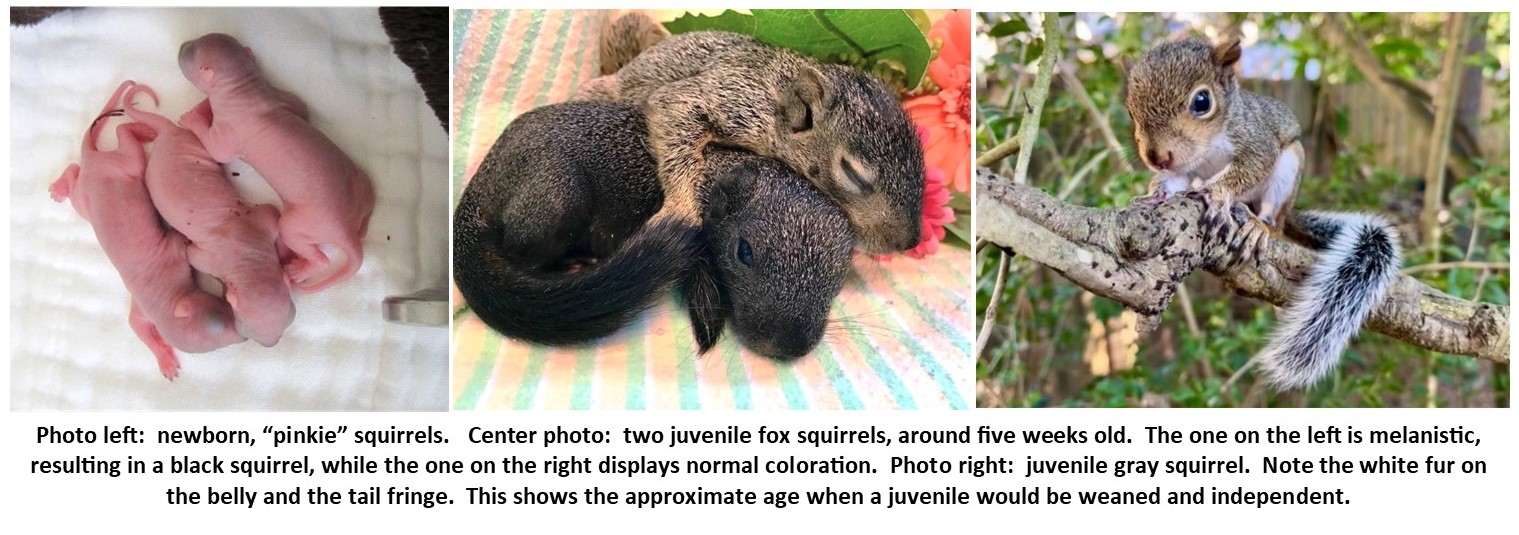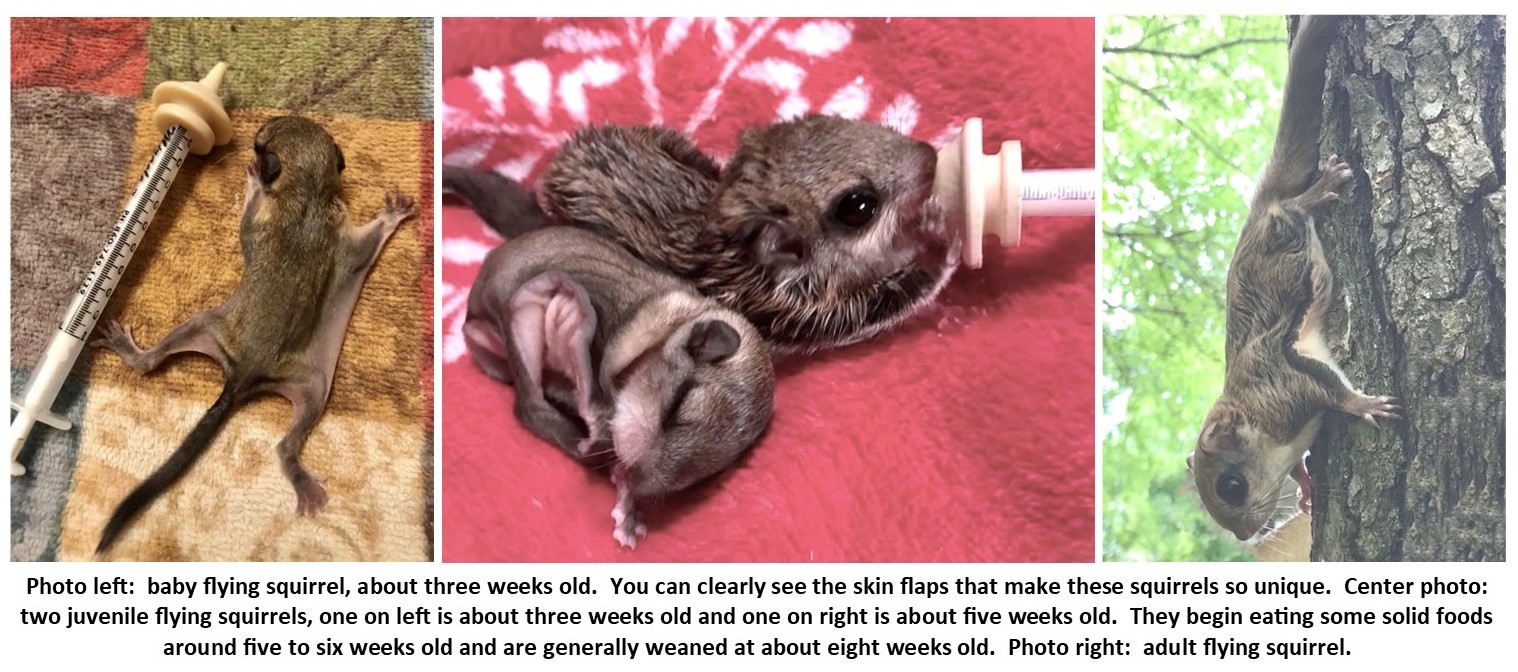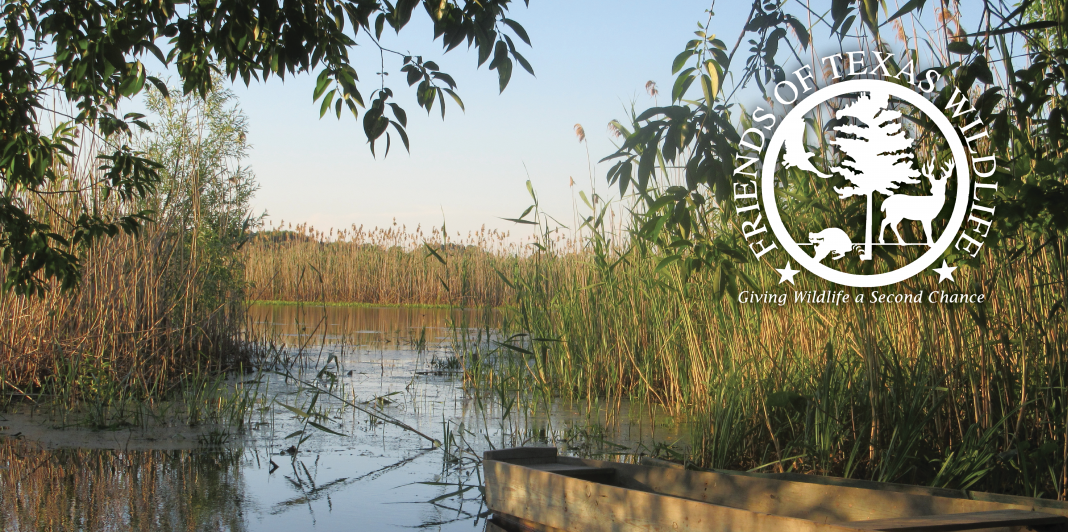Baby Squirrels Again
September! Thoughts start turning towards falling leaves, eventual sweater weather, and all things pumpkin pie spice. We generally think of wildlife babies being born throughout the spring and summer, but in our area squirrels are busy nesting and raising their young in the late summer and fall, sometimes even having a second yearly litter.
We have three species of squirrels in our area; gray (sometimes called cat) squirrels, fox squirrels, and southern flying squirrels. In our area, flying squirrels generally have their young between October and January; they are seldom seen as they are quite small and nocturnal. Both gray squirrels and fox squirrels may have a litter very early in the year (January through March), and again from July through October.
The fox squirrel is the largest squirrel in our area. They have small ears (in comparison to the size of their head), are mainly gray on their back and head, and have distinctive orange fur on the throat and chest. Additionally, their tail is fringed in orange fur. Occasionally we see melanistic fox squirrels in our area; they can either be totally black, or have black fur tipped in some orange. Although they are our largest squirrel, they are generally quite passive and tend to stay in more rural areas, preferring to not compete with the somewhat smaller gray squirrels. Only the females are involved in nest building and the rearing of the young. They typically have two to four pups; the babies are born without any hair, eyes and ears closed, and they are totally helpless. They are referred to as pinky squirrels. Female squirrels generally build several nests so that if one is destroyed by storms, predators, or is infested with insects, she can move her young to an alternate nest (this is true for gray squirrels as well). By two weeks old, the young begin to get a slight cast of fur. By five weeks of age, the babies are fully furred and their eyes open. The tail will continue to “fluff out” over the next several weeks. The babies will begin exploring a bit at about six weeks of age, and also begin nibbling on some solid foods. They are typically weaned at about eight to twelve weeks of age, at which point they are mostly independent.
 Gray squirrels are slightly smaller than fox squirrels; their ears appear somewhat larger than those of the fox squirrel. They have gray fur on their back and head, while the fur on their underside is white. Their tails are fringed in white fur. Gray squirrels are quite adaptable to living in urban and suburban areas and don’t seem to mind living in close proximity to people. As with fox squirrels, the females do the nest building and rearing of the young. Typical litter size is generally three to five pups, and the young are also born hairless. Their eyes open at five weeks of age, and they usually begin exploring outside of the nest at around six weeks of age. They begin eating some solid foods at this age and are generally weaned by around eight weeks old. Generally, once the pups can sit upright and hold their tail in an “S” position, they are old enough to be independent. Their tails at this point are only about an inch wide; it will continue to “fluff out” in the coming weeks.
Gray squirrels are slightly smaller than fox squirrels; their ears appear somewhat larger than those of the fox squirrel. They have gray fur on their back and head, while the fur on their underside is white. Their tails are fringed in white fur. Gray squirrels are quite adaptable to living in urban and suburban areas and don’t seem to mind living in close proximity to people. As with fox squirrels, the females do the nest building and rearing of the young. Typical litter size is generally three to five pups, and the young are also born hairless. Their eyes open at five weeks of age, and they usually begin exploring outside of the nest at around six weeks of age. They begin eating some solid foods at this age and are generally weaned by around eight weeks old. Generally, once the pups can sit upright and hold their tail in an “S” position, they are old enough to be independent. Their tails at this point are only about an inch wide; it will continue to “fluff out” in the coming weeks.
Flying squirrels are more unique in their breeding habits. Our southern flying squirrels are quite small, only about the size of a pet hamster, and their tails (even though fluffy) are flat. They have flaps of skin stretching between their front and back legs, so they don’t actually “fly”, but they glide, somewhat like a hang glider, between trees. They use their tails like a rudder to help them balance and steer. They prefer to nest in tree cavities, and they will also sometimes take up residence in bird houses. They sometimes live in small colonies, especially in colder weather, and the group will share stashed food. The babies are quite tiny when born, hairless and defenseless, but the characteristic skin flaps are clearly evident. The young will generally stay with their mother and/or the colony until the spring.
 If you happen to find a squirrel baby on the ground, give mom a chance to retrieve her baby. The baby can be placed in a small box, lined with some leaves or a soft cloth. Place the box at the base of the nearest tree; if it’s not safe to leave the box on the ground, it can be temporarily nailed or bungee corded to the tree. Try to assure the baby is not in direct sunlight, and if outside temperatures are cooler a sock filled with dry rice or birdseed and microwaved until it’s warm can provide supplemental heat. Give mom at least a few hours to retrieve her baby. If you happen to find a baby at or close to dark, keep it safe, quiet, and warm overnight. Some warmed Pedialyte can be given slowly in a small syringe or eye dropper to help hydrate the baby, but please never feed any milk, formula, or other foods; babies that are dehydrated or not warm enough cannot digest it anyway, so feeding improperly can potentially kill the baby or cause serious digestive issues. All these instructions can be found on our website.
If you happen to find a squirrel baby on the ground, give mom a chance to retrieve her baby. The baby can be placed in a small box, lined with some leaves or a soft cloth. Place the box at the base of the nearest tree; if it’s not safe to leave the box on the ground, it can be temporarily nailed or bungee corded to the tree. Try to assure the baby is not in direct sunlight, and if outside temperatures are cooler a sock filled with dry rice or birdseed and microwaved until it’s warm can provide supplemental heat. Give mom at least a few hours to retrieve her baby. If you happen to find a baby at or close to dark, keep it safe, quiet, and warm overnight. Some warmed Pedialyte can be given slowly in a small syringe or eye dropper to help hydrate the baby, but please never feed any milk, formula, or other foods; babies that are dehydrated or not warm enough cannot digest it anyway, so feeding improperly can potentially kill the baby or cause serious digestive issues. All these instructions can be found on our website.
To learn more about what we do and view pictures of many of the animals we assist, please visit our Facebook page at www.facebook.com/SavingTexasWildlife. Details and more specifies-specific flowcharts regarding how to help found animals can be viewed on our website at www.ftwl.org (click on “Help and Advice”). These charts are extremely helpful to determine if an animal truly needs rescuing or not. If you need assistance with a wildlife animal you have found, please call us at 281-259-0039 or email us at [email protected]. We offer many educational programs (including camps, birthday parties, educational presentations, and Second Saturdays). Our educational visitor’s center is open the second Saturday of each month from 10 a.m. to 2 p.m., located at 29816 Dobbin Hufsmith Road, Magnolia, Texas.





















